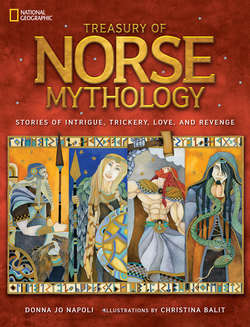Читать книгу Treasury of Norse Mythology: Stories of Intrigue, Trickery, Love, and Revenge - Christina Balit - Страница 13
ОглавлениеLoki had many offspring, but three were horrendous: the wolf Fenrir, fated to kill Odin in the battle Ragnarok; the serpent Jormungand, whose venom would kill Thor in that battle; and hungry Hel, who would keep Odin’s son, Balder, prisoner.
LOKIS MONSTROUS CHILDREN
Loki made everyone edgy.
Loki was the son of the giant Farbauti and the goddess Laufey. Several gods took giantesses as wives, and their offspring did fine. But it was taboo for a goddess to take a giant as a husband; thus, Loki was born with a giant (so to speak) strike against him. But at one point he and Odin mixed blood and thus became blood brothers. Odin, in fact, promised that he would always share drink with Loki. This meant that Loki was counted among the Aesir.
From the start, Loki was spiteful, and that spirit proved to be inheritable. Hapless wives bore him wretched children, three notable for their evilness: the chaos monsters, children by the frost giantess Angrboda. The first was the vicious wolf Fenrir; the second, the serpent Jormungand; and the third, the horrible hag Hel. At first, the children lived with their mother in Jotunheim. But everyone in Asgard knew they were destined to cause cosmic misery eventually. The gods couldn’t kill these children—for no one can interfere with fate. But they wanted to be rid of them in the meantime. So the one-eyed Odin had a band of gods sneak into Jotunheim one night and gag and bind the giantess Angrboda and kidnap the children.
The wolf Fenrir was the son of Loki and a vicious, frightful creature. Odin had him bound in chains and brought to Asgard. But it was hard to capture him: The god Tyr lost his right hand in doing it.
Tricksters and Sneaks
A Native American rock painting, possibly of Coyote
Tricksters appear in many traditions. Some native tribes of North America have Coyote, a well-known prankster, but he reveals people’s weaknesses, so he’s listened to. The Greek god Hermes was a liar and thief, yet he was eloquent and could convince anyone of anything. Coyote, Hermes, and Loki are shape-shifters. But Coyote is neither good nor evil, Hermes is simply an annoyance, and Loki is wicked. Both Odin and Thor seek Loki out sometimes, however, to use his ability to deceive for good goals.
Odin decided the wolf Fenrir should live in Asgard, perhaps so he could keep an eye on him. After all, Fenrir was destined to kill Odin at the final battle of Ragnarok. The inhabitants of Asgard were not delighted with the prospect of this beast living among them. The only one who dared get close enough to the wolf to feed him was Odin’s son Tyr, whose mother was a giantess and who was bolder than others—a true god of war. Still, as Fenrir grew, fear of him grew until people wanted to tie him up. But they didn’t want Fenrir to realize he was being tied up. They pretended they were having a bet, to see if the wolf was strong enough to break binding chains. Fenrir agreed, and immediately burst from his fetters. The gods made a second chain, twice as strong as the first. Fenrir burst out of it easily. So Odin sent Frey’s servant Skirnir to the dark elves, to ask them to forge a chain strong enough to bind Fenrir. The chain they forged was of the sound of a cat footfall, the beard of a woman, the roots of a mountain, the sinews of a bear, the breath of fish, and the spit of birds. This chain was called Gleipnir, and it brushed against your skin soft as silk. The gods took Fenrir to the island Lyngvi in the lake Amsvartnir and asked him to submit to being tied with Gleipnir.
